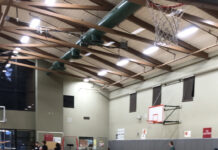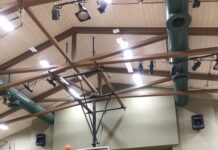It happened that late Thursday afternoon last week, a visitor appeared in the office to speak with me. I would say it was a pleasant surprise but most people show up without appointments so “surprise” may not be the appropriate word — probably pleasant “diversion from the mundane chores of budgets and management” fits the bill.
Kevin Brennan, California Fish and Wildlife biologist for our area and others, popped by to talk about wildlife and other things that interest us.
I always find his visits a delight.
He maintains a home here and off the Hill with his wife Deborah, a journalist I highly respect whom I came to know through a knitting group we once belonged to on the Hill.
He came up after a report of a mountain lion in the Daryll Road area. He said most of these reports turn up to be false — bobcats, two squirrels on a rock, etc. — but he checks out the report anyway.
When he came by my office, he had just scouted around the area finding no tracks or evidence of any kind of a lion and then got back into his truck. Another case of mistaken identify.
Sitting inside, making notes on his clipboard, he glanced up in his rearview mirror to see the lion walking along the road behind his truck. A big smile appeared on his face. This man loves his job.
Recently, Frank Baele sent me photos of an encounter he had with a bear. The bear destroyed some of his bird feeders and caused a great deal of noise one night in late May. Frank went out, met the bear face-to-face, and beat on some pots and pans to scare him off. It worked.
His outside cam took some great black-and-white photos of the bear. A few days before Kevin stopped by, at Frank’s request, I forwarded them to Kevin, who confirmed this was the Banning Rite Aid bear who appeared last year about the same time on the Hill.
That led me to ask some questions about the coincidence of bear sightings about the same time this year.
Here are some brief facts I learned: Bears rely on grass for nutrition in the spring. Around May 1 is when F&W gets calls about bear sightings because that’s when the grasses are turning brown and the bears are moving into residential areas seeking nutrition.
They find it in bird seed. They find it in garbage left outside. Right now, the fact that they are a nuisance to people like Frank is just a smoke alarm, Kevin said. But if we as a community don’t start bear-proofing our yards, the smoke alarm will turn into a fire alarm.
Then the bears may become aggressive. He pointed out that the Transfer Station is open five days a week so there’s little excuse for keeping garbage stored outside to attract bears.
Kevin plans to give more talks on the Hill about the black bears who are not native to these mountains. The grizzlies were but they’ve been long gone from California for decades.
In 1933, 33 black bears (22 male, 11 female) were introduced into the San Gabriel and San Bernardino (not San Jacinto) mouuntains. The mortality rate on relocating bears is high. Kevin estimates maybe three survived and the bears we’re seeing probably descended from them. DNA testing may occur in the future to confirm or deny this.
Is this prime black bear country, though? Kevin says probably not. Why? Because the soil isn’t rich enough to support the abundance of grasses they need. We have too much granite.
Some areas of the San Bernardino Mountains do have rich soil to support these grasses.
But, he observed, if we ever see a mother bear and her cubs, then we most likely have an established bear population.
I asked if we should be concerned about the mother bear of that yearling spotted in Pine Cove recently and he said no. A yearling is no longer considered a baby bear. That guy or gal is on its own.
Let’s just be grateful for the few bears we do have and not create a problem for them by leaving out our garbage. It’s nice to have such a diversity of wildlife.
Another another thing; if you see a young wild thing alone, leave it be. Read the story on page A5 to find out why.
Becky Clark, Editor










